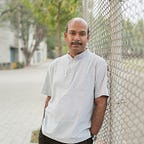Ganapati Muni’s Vision of Parashurama at Mahendragiri
Akshaya Tritiya is a day of immense significance in the Hindu calendar, marking the birth of Parashurama, the sixth avatar of Bhagavan Vishnu. Parashurama, known for his valiant and fiery spirit, is also celebrated for his deep tapasyā and devotion. Among the many places associated with Parashurama’s legend, Mahendragiri Hill in Gajapati district, Odisha, and near to Srikakulam district, Andhra Pradesh, holds a special significance. Here, amidst the serene landscape, lies a story of spiritual awakening that has fascinated devotees for generations.
Mahendragiri, often considered a Parashurama Kshetra, is home to the ancient Gokarneshwara Temple. This sacred site has an aura of timelessness, believed to have been installed by Kartikeya, son of Lord Shiva, and worshipped by Parashurama himself. According to the Udyogaparva (176.31) section of the Mahabharata, Mahendragiri was the mountain where Parashurama performed his eternal tapasyā (महेन्द्रं वै गिरिश्रेष्ठं रामो नित्यमुपास्ति ह mahendraṃ vai giriśreṣṭhaṃ rāmo nityamupāsti ha). It’s a place where spiritual energy resonates, drawing seekers from far and wide.
One such seeker was Vasishtha Kavyakantha Ganapati Muni, the foremost disciple of Bhagavan Ramana Maharshi. Ganapati Muni was a revered scholar, poet, and saint who sought the deeper truths of spirituality through meditation and tapas. In 1916, accompanied by his disciple Daivarata, Ganapati Muni journeyed to Mahendragiri with a sense of anticipation, drawn by the mountain’s reputation for spiritual intensity.
While at Mahendragiri, the Muni felt an overwhelming presence, a force that seemed to emanate from the very core of the mountain. Driven by this sensation, he began a profound meditation that lasted for twenty days. During this time, he remained in complete silence, with Daivarata acting as his guardian and witness.
On the twentieth day, something extraordinary happened. A figure appeared before Ganapati Muni — a man with an axe in his hand, robed in white, with the demeanor of a Rishi. This mysterious form radiated a divine energy, a brilliant ray of light emanating from his forehead. The light touched Ganapati Muni’s head, sending a surge of electric energy through his body. This encounter was transformative. The Muni awoke from his meditative state, filled with a newfound vigor, and declared to Daivarata, “I have attained to the Grace of Parashurama.” The radiance surrounding Ganapati Muni was unmistakable, a sign that he had experienced something profound.
This experience left a lasting impression on both Ganapati Muni and Daivarata, confirming the sacredness of Mahendragiri and its connection to Parashurama. It also illustrated the spiritual power of tapas, meditation, and unwavering devotion.
Parashurama symbolizes extreme aggressive power, which annihilates egoism and manifests pure strength necessary for the destruction of asuric forces. His manifestation was to transmit this Shakti to Sri Rama, which was needed for the destruction of Ravana. This Shakti has been described as Kundalini Shakti, given to Parashurama by his mother, Renuka.
A decade before his vision of Parashurama at Mahendragiri, Ganapati Muni had the vision of the Divine Mother Renuka, whose essence embodies the potent force of Kundalini Shakti.
In 1906, Ganapati Muni went with his family on a pilgrimage to the sacred Renukambal Temple situated in Padai Veedu, on the banks of the river Kamandalu near Vellore, Tamil Nadu. The very name Padai Veedu, meaning the head of a snake, alludes to the symbolic significance of rising of Kundalini energy, which lies dormant at the base of the spine, awaiting awakening. It is said that this temple is home to a self-grown image of Renuka Devi, symbolizing her inherent divine presence.
Ganapati Muni’s vision of Renuka Devi was a soul-stirring communion with the embodiment of all mantras, the primal source of divine energy. In the sacred precincts of the temple, Ganapati Muni beheld the divine forms of Bhuvaneswari, Kali, Tara, and Nanda Devi, among others, as manifestations of the Supreme Mother Power. As Renuka Devi revealed herself in her myriad forms, the Kundalini Shakti within Ganapati Muni stirred, rising from its dormant state and flooding his being with blissful ecstasy.
This divine communion was a significant moment in Ganapati Muni’s spiritual journey. Empowered by the awakened Kundalini Shakti, he became proficient in all mantras, attaining siddhi in their recitation and unlocking the mystical potential encoded within each sacred syllable. The verses composed by Ganapati Muni in praise of Renuka Devi, including the revered reṇukāṣaṭkam, reṇukāsaptakam, and reṇukāgītam, well illustrate his deep reverence and devotion towards the Divine Mother.
In times of distress, invoking the grace of Renuka Devi becomes imperative. Just as Parashurama embodied the fierce power necessary to vanquish asuric forces, Renuka Devi, the bestower of Kundalini Shakti, holds the key to annihilating the egoism and ignorance that plague humanity. Through heartfelt prayers and unwavering devotion, may we beseech Mother Renuka to awaken her divine energy within us, leading us from darkness to illumination, from turmoil to tranquility.
तनयरोदनं श्रवणशालिनि । शृणुसुरार्चिते यदि दया हृदि ॥
tanayarodanaṃ śravaṇaśālini . śṛṇusurārcite yadi dayā hṛdi ..
(Renukagitam 18 of Ganapati Muni)
O Mother Renuka, you are adored and worshipped even by the devas; O adorable Devi, if you have slightest compassion in your heart for these ignorant children of yours, then listen to their sincere prayers.
-Sampadananda Mishra
